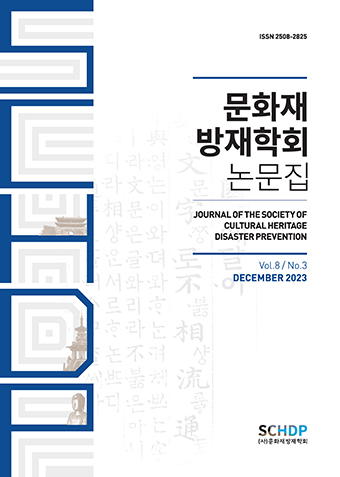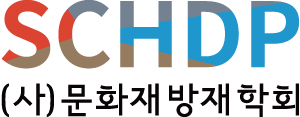Article
Abstract
References
Information
Wooden Cultural Heritage should be preserved and managed in the original form securing the structural stability while it is being repaired or reinforced due to aging for their long existence. Currently, there is a lack of basic data to propose the criteria for when the wooden cultural heritage should be repaired. For the recent preservation of cultural properties, HBIM is used to input the repair history based on the information and repair data of the targeted cultural heritage, and it would be used for the purpose of repair and preservation of the heritage in the future. This study aims to select items to prepare standards for the maintenance of traditional wooden cultural heritage based on the load transmission mechanism of traditional wooden structures along with the safety management guidelines in the Cultural Heritage Protection Act and use them as the basic data for the future cultural heritage conservation management system.
전통목조문화재는 오랜 존치기간으로 재료가 노후화되어 보수 또는 보강하여 원형을 유지하면서 구조적 안정성을 확보한 상태로 보존・관리되어야 한다. 그러나, 현재 전통목조문화재를 보수해야 하는 시기의 기준을 제안하기 위한 기초자료가 부족한 실정이다. 최근 문화재 보존을 위해서는 HBIM을 활용하여 대상 문화재의 자료와 보수 자료 등을 토대로 수리이력 등을 확인하여 향후 문화재를 수리 및 보존을 위한 자료로 활용하고자 한다. 본 연구는 문화재보호법에 규정되어 있는 안전관리방안지침과 함께 전통목조문화재의 하중전달 메커니즘을 기반으로 전통목조문화재 유지관리 기준(안)을 마련하기 위한 항목을 선정하고 향후 HBIM 등의 문화재 통합 보존관리시스템 구축을 위한 기초데이터로 활용하고자 한다.
- Cho, C.H., Choi, J.S., Cho, C.H., Yoon, W,K., Kim, J.S. (2002). A Case Study on Structural Safety of Traditional Wooden Architecture - Focused on the main building of Wanju Songgwang Temple-, Architectural Institute of Korea, Korea.
- Choi, H.S. (2014). A study on the possibility of reconfigurations of architectural cultural assets spatial Information by BIM -The case of spatial configurations of Sungnyemun recovery process-, the Korea Institute of Building Construction, Korea.
- Cultural Heritage Administration, Order No. 516, Guidelines for the Operation of Regular Survey of State-designated Cultural Properties and State-registered Cultural Properties.
- Jeong, I.H., Jung, J.J., Choi, H.S. (2008). BIM as the application for Preserving and Documenting Architectural Archives of Korean Cultural Properties, Architectural Institute of Korea, Korea.
- Kim, H.J., Kim, W.J., Shin, E.M., Ha, T.U. (2020). Verification of the method of calculating the load by column of traditional wooden building by constant measurement of building weight, Architectural Institute of Korea, Korea.
- Kim, S.Y., Jeon, B.H. (2013). Current state and drawbacks of Han-ok parametric modeling, Architectural Institute of Korea, Korea.
- Kim, Y.M. (2021). Structural Check of Korean Traditional Timber Structure by Structural Monitoring, Architectural Institute of Korea, Korea.
- Oh, J.E. (2020). A Study on Automatic Shape Evaluation System for 3D Scanning Data of Cultural Heritage, Graduate School of Cultural Heritage, Korea National University of Cultural Heritage, Korea.
- Park, J.H., Choi, H.S., LEE, S.R., AN, D.W., CHOI, C.H., Kim, S.W. (2012). Considerations Analysis of Libraries Development for BIM Based Restoration and Maintenance Management of Cultural Heritages, Architectural Institute of Korea, Korea.
- Shin, B.U. (2019). A Study on the Utilization of Documentation using BIM on Wooden Architectural Cultural Assets, Journal of the Korean institute of rural architecture, Korea. 10.14577/kirua.2019.21.4.25
- Publisher :The Society of Cultural Heritage Disaster Prevention
- Publisher(Ko) :문화재방재학회
- Journal Title :Journal of the Society of Cultural Heritage Disaster Prevention
- Journal Title(Ko) :문화재방재학회논문집
- Volume : 8
- No :3
- Pages :189-196



 Journal of the Society of Cultural Heritage Disaster Prevention
Journal of the Society of Cultural Heritage Disaster Prevention




